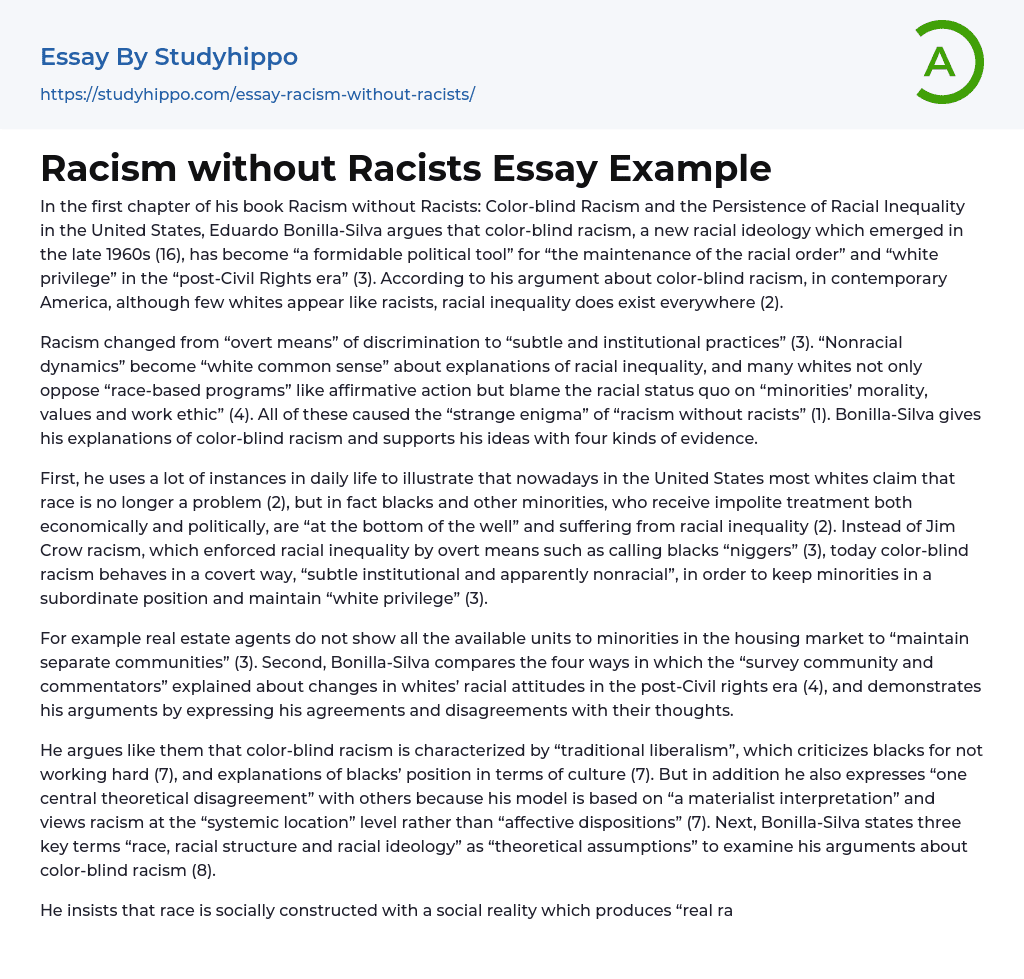In the first chapter of his book Racism without Racists: Color-blind Racism and the Persistence of Racial Inequality in the United States, Eduardo Bonilla-Silva argues that color-blind racism, a new racial ideology which emerged in the late 1960s (16), has become “a formidable political tool” for “the maintenance of the racial order” and “white privilege” in the “post-Civil Rights era” (3). According to his argument about color-blind racism, in contemporary America, although few whites appear like racists, racial inequality does exist everywhere (2).
Racism changed from “overt means” of discrimination to “subtle and institutional practices” (3). “Nonracial dynamics” become “white common sense” about explanations of racial inequality, and many whites not only oppose “race-based programs” like affirmative action but blame the racial status quo on “minorities’ morality, v
...alues and work ethic” (4). All of these caused the “strange enigma” of “racism without racists” (1). Bonilla-Silva gives his explanations of color-blind racism and supports his ideas with four kinds of evidence.
First, he uses a lot of instances in daily life to illustrate that nowadays in the United States most whites claim that race is no longer a problem (2), but in fact blacks and other minorities, who receive impolite treatment both economically and politically, are “at the bottom of the well” and suffering from racial inequality (2). Instead of Jim Crow racism, which enforced racial inequality by overt means such as calling blacks “niggers” (3), today color-blind racism behaves in a covert way, “subtle institutional and apparently nonracial”, in order to keep minorities in a subordinate position and maintain “white privilege” (3).
For example real estate agents do not sho
all the available units to minorities in the housing market to “maintain separate communities” (3). Second, Bonilla-Silva compares the four ways in which the “survey community and commentators” explained about changes in whites’ racial attitudes in the post-Civil rights era (4), and demonstrates his arguments by expressing his agreements and disagreements with their thoughts.
He argues like them that color-blind racism is characterized by “traditional liberalism”, which criticizes blacks for not working hard (7), and explanations of blacks’ position in terms of culture (7). But in addition he also expresses “one central theoretical disagreement” with others because his model is based on “a materialist interpretation” and views racism at the “systemic location” level rather than “affective dispositions” (7). Next, Bonilla-Silva states three key terms “race, racial structure and racial ideology” as “theoretical assumptions” to examine his arguments about color-blind racism (8).
He insists that race is socially constructed with a social reality which produces “real race effects” through social structure that “reinforces racial privilege” (9), and he also analyzes the racial ideology which is used to justify the “status of various races” (9). Finally, he relies on interview data as methodology to make cases and uses two survey research data to strengthen his arguments (11). Bonilla-Silva believes color-blind racism is a new ideology that now many whites believe in to maintain their privilege, and results in racial inequality accomplished by covert behaviors.
It inspires me to explore a profound question: how do we define equality. Does equality mean that everybody earns the same amount of money? Or does it mean the equal opportunity for people to make a living? When we talk
about pursuing social equality, what kind of equality is considered? I wonder whether it will cause true equality if we give blacks and other minorities extra opportunities and support to help them overcome difficulties. I hope to have a deep understanding about the meaning of equality, fairness, justice and impartiality.
- Gender equality essays
- Equality essays
- Segregation essays
- Gender Inequality essays
- Minority essays
- Social Inequality essays
- Gender Inequality In The Workplace essays
- Malcolm X essays
- Black Lives Matter essays
- Antisemitism essays
- Ku Klux Klan essays
- Miscegenation essays
- Racial Segregation essays
- I Have a Dream essays
- Martin Luther King essays
- Racial Inequality essays
- Black History Month essays
- Black People essays
- Abortion essays
- Abuse essays
- Animal Rights essays
- Animal Testing essays
- Assault essays
- Bullying essays
- Controversial Issue essays
- Crash essays
- Cyber Bullying essays
- Feminism essays
- Human Rights essays
- Immigration essays
- Inequality essays
- Poverty essays
- Prejudice essays
- Racism essays
- Torture essays
- Violence essays




